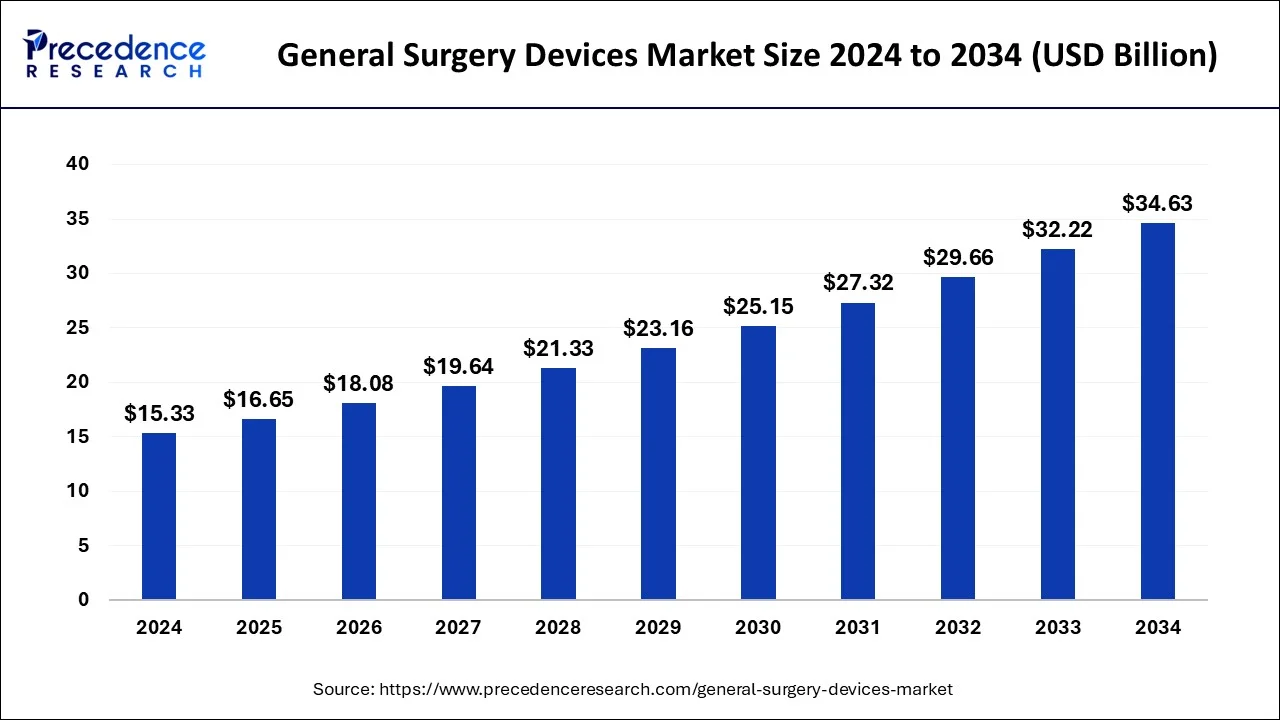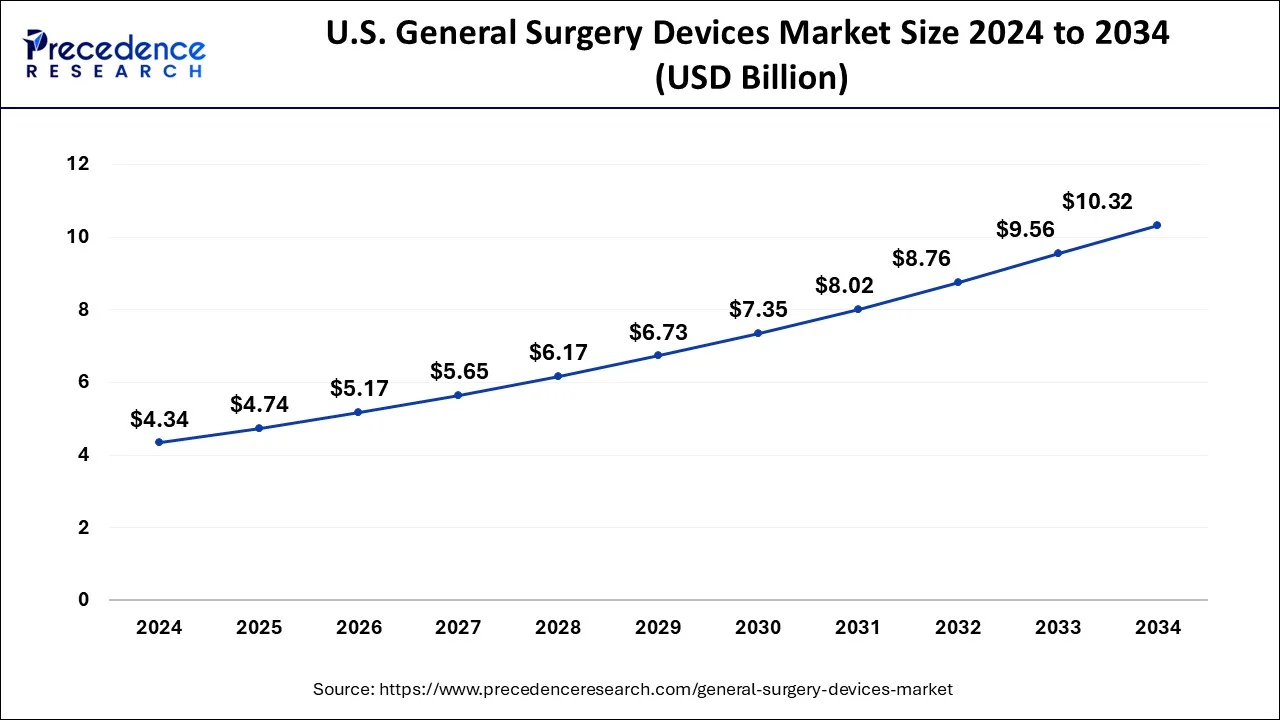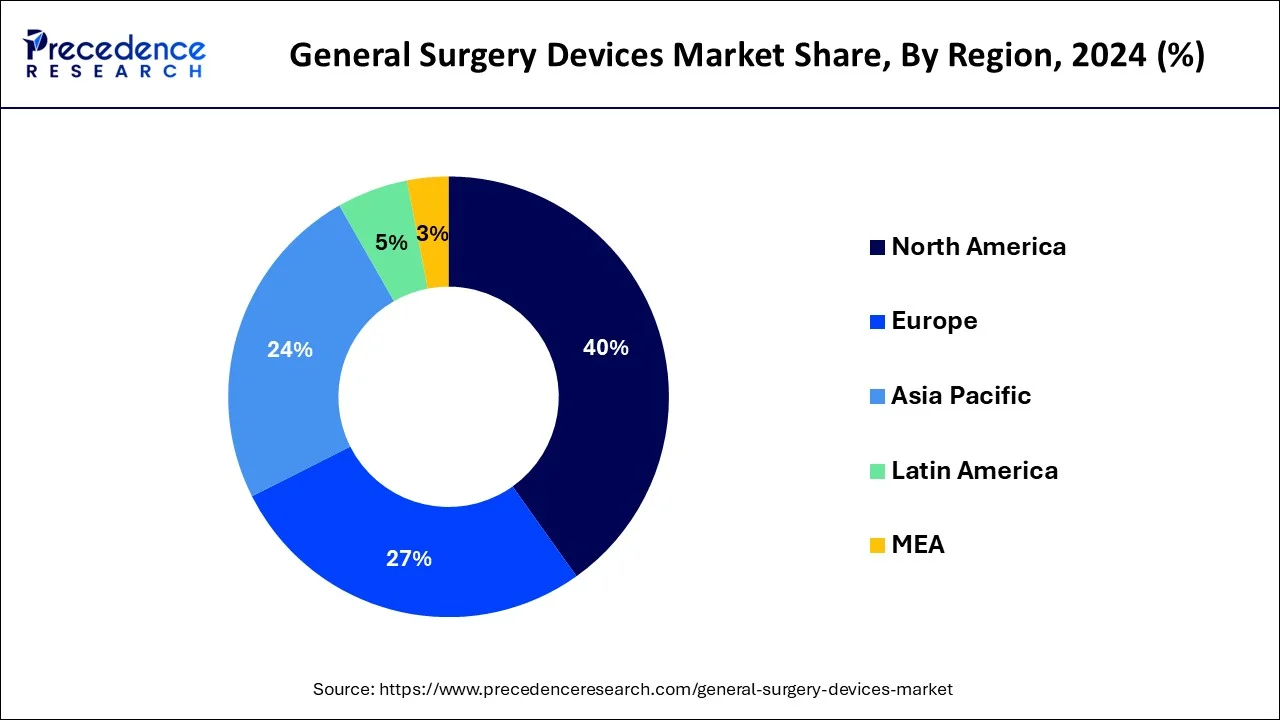November 2024
The global general surgery devices market size is calculated at USD 16.65 billion in 2025 and is forecasted to reach around USD 34.63 billion by 2034, accelerating at a CAGR of 8.49% from 2025 to 2034. The North America market size surpassed USD 610 million in 2024 and is expanding at a CAGR of 8.66% during the forecast period. The market sizing and forecasts are revenue-based (USD Million/Billion), with 2024 as the base year.
The global general surgery devices market size accounted for USD 15.33 billion in 2024 and is expected to exceed USD 34.63 billion by 2034, growing at a CAGR of 8.49% from 2025 to 2034. The geriatric population is prone to surgeries, which drives the general surgery devices market.

The application of sophisticated algorithms, machine learning methods, and other AI-related technologies to improve the functionality and performance of medical equipment is known as artificial intelligence (AI) in medical devices. AI in medical equipment increases the precision of diagnoses, helps with surgery, forecasts patient outcomes, and customizes therapy regimens. The quality of surgical simulation, which is becoming a more and more common technique for improving a surgeon's training experience, is greatly improved by artificial intelligence (AI). Different AI algorithms are used by a number of surgical visualization systems that are now in use for presurgical evaluation and anatomical teaching.
The U.S. general surgery devices market size was evaluated at USD 4.34 billion in 2024 and is projected to be worth around USD 10.32 billion by 2034, growing at a CAGR of 9.04% from 2025 to 2034.

North America dominated the global general surgery devices market in 2024, in terms of revenue and is expected to remain dominant throughout the forecast period. The population of North America is growing older. According to the World Bank, around 65% of the population in U.S. was above 30 years of age in 2020. Further, the increased income coupled with increased awareness regarding various surgical approaches is fostering the market growth in North America. U.S. is the leading market in North America due to better government regulation regarding the surgical devices and improved penetration of surgical centers.

Asia Pacific is estimated to be the most opportunistic market during the forecast period. This is attributable to increased awareness, increasing penetration of healthcare and surgical facilities, heavy investments on research & development, and rising medical tourism industry in the region. The markets like China and India is expected to witness significant growth rates in the forthcoming years owing to its huge population and rapid urbanization.
The equipment, instruments, and tools used by surgeons to carry out different surgical operations are known as general surgery devices. Cutting, coagulating, retracting, gripping, suturing, and other surgically required operations are only a few of the many uses for these instruments. In order to execute safe and efficient procedures across a variety of specialties, including orthopedic, cardiovascular, and gastrointestinal surgery, among others, general surgery instruments are essential. Precision, fewer surgical complications, and better patient outcomes are all guaranteed by the use of cutting-edge, dependable surgical tools. High-quality general surgery equipment is essential for meeting the demands of an aging population, an increase in chronic illnesses, and changing healthcare standards, as well as the growing need for both minimally invasive and traditional procedures worldwide.
| Report Coverage | Details |
| Market Size in 2025 | USD 16.65 Billion |
| Market Size by 2034 | USD 34.63 Billion |
| Market Growth Rate from 2025 to 2034 | CAGR of 8.49% |
| Largest Market | North America |
| Base Year | 2024 |
| Forecast Period | 2025 to 2034 |
| Segments Covered | Type, Application, and Regions |
| Regions Covered | North America, Europe, Asia-Pacific, Latin America, and Middle East & Africa |
Demand for minimally invasive surgeries
One of the main drivers of the general surgical devices market is the increasing acceptance and awareness of minimally invasive surgery. Due to their many benefits, including less postoperative discomfort, shorter hospital stays, and faster recovery durations, these surgical methods are favored by both surgeons and patients. As more people become aware of the advantages of minimally invasive procedures, more hospitals are outfitted with the technology and surgical tools needed to satisfy this demand.
High cost of general surgical devices
Market penetration may be impacted by the high expenses of these devices combined with restrictions on reimbursement, which may restrict access to cutting-edge surgical technology. Another issue facing the market for general surgery devices is cost. Particularly for healthcare facilities with tight budgets or patients in lower-income areas, the cost of general surgery equipment and supplies is essential.
Robotic surgical devices
The quantity of novel robotic tools created for surgical procedures has steadily increased in recent years. The market has expanded quickly to become a multibillion-dollar sector. Commercial robots for a variety of surgical operations have been created in considerable numbers. The development of imaging techniques, including computed tomography (CT), magnetic resonance imaging (MRI), and ultrasound (US), as well as improvements in processing power and related technologies, have significantly helped the area of robot-assisted surgery.
The major factors influencing the global general surgery devices market includes rising geriatric population, introduction of RFID technology, introduction of blockchain technology, rising demand from the emerging economies, growing awareness regarding surgical facilities, and growing burden of diseases to cite a few. The popularity of portable surgery devices is increasing. The rising prevalence of chronic diseases among the population. The cost of treatment in hospitals is costlier. Therefore, people are increasingly adopting the use of portable surgery devices and prefers to get the treatment at home. This factor is boosting the market growth in developed markets. However, the high cost of surgery devices is a key restraining factor. The heavy investments due to the technological advancements in the surgery devices have resulted in the high prices of the surgical devices. The acquisition cost of advanced surgery devices is very much high and further, its maintenance cost is also high. This hinders the growth of the market especially in the developing and underdeveloped markets.
By type, disposable supplies segment led the global general surgery devices market with remarkable revenue share in 2024. This is attributed to the high demand for the disposable devices such as catheters, needles, and syringes. Moreover, government regulations regarding proper disposal of such devices is propelling the segment growth.
Medical robotics and computer assisted general surgery devices segment is estimated to be the most opportunistic segment during the forecast period. This is attributed to the extensive investments on research & development and adoption of robotics in surgery, especially in minimally invasive surgeries.
By application, the orthopedic surgery segment held the major revenue share in the global general surgery devices market in 2024 owing to the rising bone disease among the geriatric population. Furthermore, the growing usage of smart and AI guided devices and robotics in the orthopedic surgery is exponentially contributing towards the segment growth.
On the other hand, wound care is projected to show the fastest growth due to the rising number of road accident cases. The growing penetration of healthcare units across the globe is positively contributing towards the growth of this segment.
By Type
By Application
By Geography
For inquiries regarding discounts, bulk purchases, or customization requests, please contact us at sales@precedenceresearch.com
No cookie-cutter, only authentic analysis – take the 1st step to become a Precedence Research client
November 2024
October 2024
March 2025
December 2024